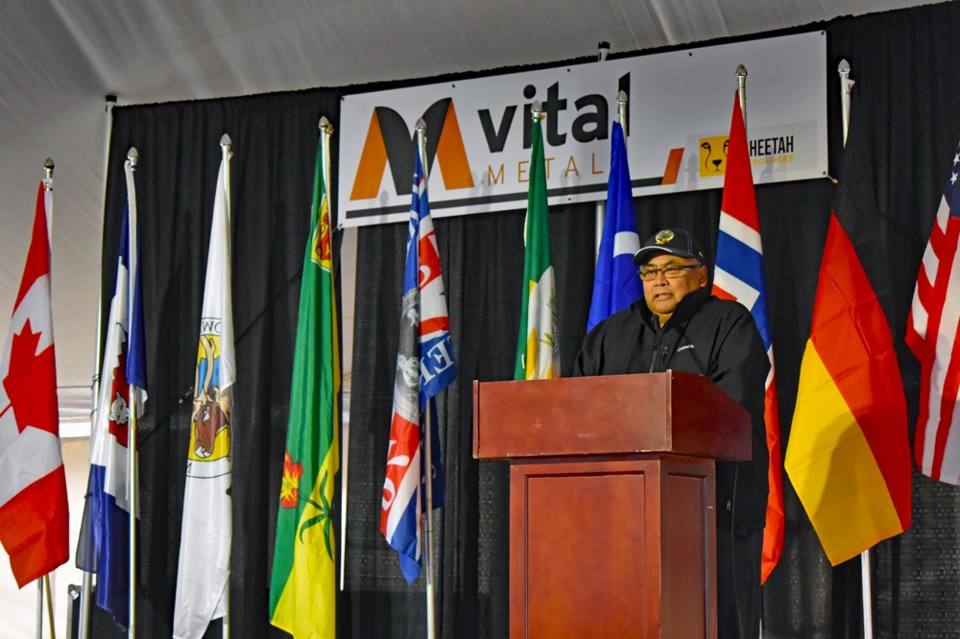SASKATOON — Yellowknives Dene First Nation Chief Edward Sangris welcomes the potential for growth of the rare earth mining sector, benefiting not only their local government but the entire country as well.
Sangris and Yellowknife MLA Caroline Wawzonek were among those who spoke during the 2022 Rare Earth Summit held on Tuesday, Sept. 20, where representatives from Australia, Germany, Norway and the United States joined their Canadian counterparts.
Sangris, the Dettah Chief of the Yellowknives Dene First Nation, congratulated the Rare Earth Extraction Plant being built by Vital Metals Ltd. They are in partnership with the Saskatchewan Research Council which has world-class rare earth processing, separation and metals facilities.
Last month, SRC unveiled the first batch of rare earth minerals ingots that were produced in Canada, near the SRC’s processing facility that is targeted to be fully operational in 2024. The facility is now being constructed with the help of Cheetah Resources, a VML company.
“As a chief representing the members of Dettah, Ndilo and Enodah we offer our friendship of the Yellowknife Dene [First Nation]. As we continue our partnership to build a stronger future for Canada’s critical mining sector, the opening of this processing plant marks an important milestone in rare earth mine and Canada’s producer of rare earth minerals,” said Sangris.
“Whenever I speak on what is important to my members, it is then my responsibility to share the wisdom with others. Since time immemorial the land has been the foundation of our people. The rich bounty of fish, plants, animals and wildlife has sustained us since the earliest days of creation.”
He added that as Dene people they place the utmost importance and respect on the land, their source of everything from their past, their present and their future.
“In addition to direct resources of the land, there are equally rich resources beneath the soil. The Northwest Territories contains geological [resources] in the province. One of the most abundant resources is the rare and precious metals in the world. We have three operating diamond mines in our traditional territories. We are proud of this wealth and all the other exploration and production,” he said.
“It is a benefit to all the people just like the processes used at Nechalacho that is [toxic] free and leaves the land and water intact without [environmental] impacts on mining projects. We have looked at Nechalacho with great interest and excitement. Our partnership has been respectful that our communities benefited from new jobs and training for our future growth and equity in this world-class mineral opportunity.”
Sangris said the rich ore and minerals that were mined underneath their traditional lands, the lands valued and taken care of by their ancestors, will help a modernized world that is moving towards cleaner and greener use of energy.
“The ores that lie underneath will be processed into the technology of tomorrow. This is another cost of celebration, the wealth of First Nations people will use to drive Canada and the world into a cleaner and greener future that will protect our families for generations to come,” he said.
Saskatchewan’s research and education in rare earth elements production is a collaboration between the private and public sectors with VML unveiling the first phase of its rare earth extraction facility in Saskatoon. The facility is alongside SRC’s $55-million vertically integrated Rare Earth Processing Facility that will include processing, separation and metals stages, which is first-of-its-kind in North America.
Rare earth minerals processed into ingots are used to manufacture permanent magnets which are used in electric vehicles, wind turbines and other electronics used in our daily lives. Rare earth ingots are an important piece of the renewable energy industry as it is dependent on large quantities of the said material. Cameras, mobile phones, and laptop computers also have sensors that require magnet materials sourced from rare earth ingots.
One bar of the rare earth mineral ingot costs from $500 to $600 in the world market making it a great revenue opportunity for the province with Saskatoon set to become the hub for the production of rare earth metal ingots in North America.


